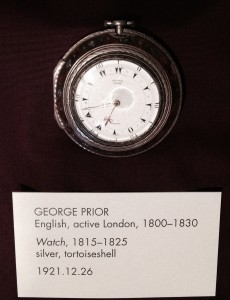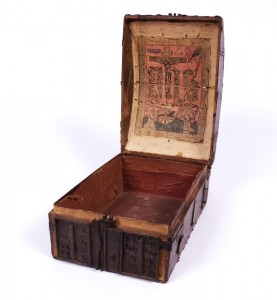As ephemeral beings, we are obsessed with the passing of time. By obsession I mean the anxiety that our mortality causes, and how we schedule, restrict, and micromanage ourselves as a result. This is manifested in our creation of objects that record time. I believe that our obsessions with such intangible things as time – the ultimate joke of nature on humanity – can be put to good use as wonderful taxonomical and organizational schemes. Today’s obsession with time is manifested in packed schedules on Google and iCalendars, in the innumerable types of alarm clocks available to us, in anxious glances to the clock on the wall. In the past, however, our obsession with the passing of time was presented in more subtle ways. In the Object Show exhibit at Bowdoin’s Museum of Art, we can see the heritage of our obsession with time in two objects: a delightful eighteenth century watch, and a remarkably intact messenger box from the fifteenth century.
The purpose of the box is itself a manifestation of the problem of time – we frame our lives according to time, yet feel that we constantly work against it. A messenger, especially in 1480 France, would be under great pressure to do his job quickly. The art inside the lid – a depiction of Judgment Day and the Passion of Christ – serves as a juxtaposition of God’s permanence and man’s mortality. Thus, the box is a symbol for obsession with time in the short-term (the messenger’s job) and the long-term (Judgment Day and eternal life).
The elegant silver and tortoiseshell watch is also linked to this joke of nature and our obsession with it. The eighteenth century piece is a symbol of modern accessibility to time and our ever-increasing anxiety about it. The luxurious metalwork is certainly aesthetically pleasing, but one must keep in mind that the beauty of this object merely masks a species-wide neurosis on our part.
This type of connection between objects that record time can be made in both directions of history – further into the past (Roman sundials, Aztec cosmological calendars) or into the present and future. Regardless of which direction one decides to go, we find an everlasting obsession with the passing of time – the greatest joke of nature.
[This post is based on an assignment from Professor Leah Zuo’s Spring 2014 class Science, Technology, and Society in China. Following a tour of The Object Show, students were asked to pick two or three objects on view and devise a new “organizational scheme” that would “traverse” or “escape” from familiar scientific/technological taxonomies.]


